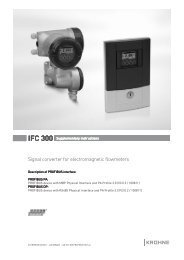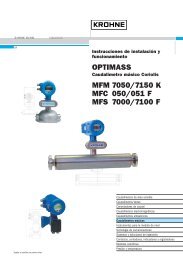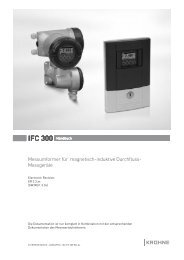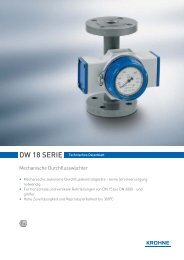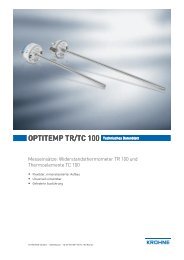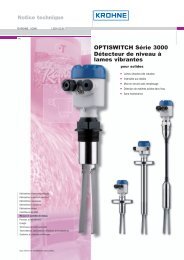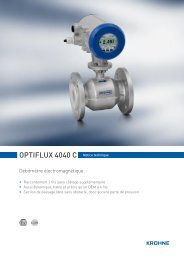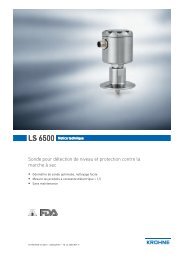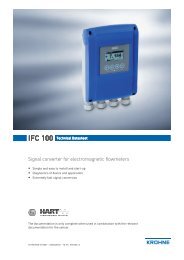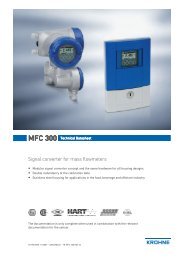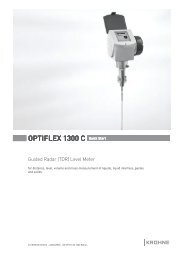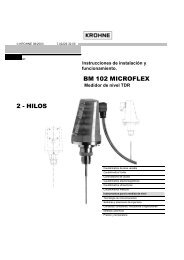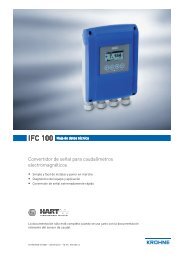Fundamentals of profibus pa networks - Krohne
Fundamentals of profibus pa networks - Krohne
Fundamentals of profibus pa networks - Krohne
You also want an ePaper? Increase the reach of your titles
YUMPU automatically turns print PDFs into web optimized ePapers that Google loves.
Interconnection <strong>of</strong> "ia" and "ib" devices.<br />
When defining which devices are allowed to be interconnected, a check should first be<br />
made on whether devices are available whose sensor can come into contact with Zone O<br />
and features restricted galvanic isolation (as a rule 500V, one additional lightning<br />
protection system required). Such devices may e.g. be conductive or ca<strong>pa</strong>citive probes.<br />
These devices are designed in category "ia" and need a segment coupler that must also<br />
have type <strong>of</strong> protection "ia" approval. Moreover, these devices compel all other users to be<br />
"ia"-certified as well. The use <strong>of</strong> such devices should be given careful consideration, since<br />
they unnecessarily increase the demands on the other bus users and rule out the use <strong>of</strong><br />
"ib"-certified devices.<br />
In all other cases, devices (incl. segment couplers) with "ia" and "ib" certification may be<br />
interconnected as required.<br />
Tip: Where a device has both "ia" and "ib" approval, it can be used in both the given cases.<br />
Gas Group IIB or IIC<br />
IIB and IIC bus components can only be interconnected if consideration is given to the<br />
safety data <strong>of</strong> the devices and the actually existing explosive atmosphere.<br />
As a rule, this means that when only a IIB gas can occur and the segment coupler is IIBcertified,<br />
all connected bus devices also need to be IIB-certified, since a IIC-device typically<br />
has not been certified with the higher safety engineering data (U, I, P).<br />
Tip: If a device has both "lIB" and "IIC" certification, there is no problem in using it for these<br />
applications.<br />
5.3 The segment coupler<br />
The name segment coupler derives from its function to link or couple the two different<br />
segments PA and DP. Further functions <strong>of</strong> the segment coupler are, typically supplying the<br />
PA segment and, if necessary, the "Ex' se<strong>pa</strong>ration. In addition, the bus termination is also<br />
located in the segment coupler. As already mentioned, a further bus termination is needed<br />
for the other end <strong>of</strong> the PA segment in order to minimize reflections <strong>of</strong> the communication<br />
signal.<br />
The bus termination consists <strong>of</strong> the series connection <strong>of</strong> a resistance (R = 100 0hm) and a<br />
ca<strong>pa</strong>citance (C = 1 uF). See also "Components from other manufacturers".<br />
Basically, two different variants <strong>of</strong> the segment coupler are available: the trans<strong>pa</strong>rent coupler<br />
with a fixed baud rate on the DP side, and the "intelligent" coupler with a variable baud rate.<br />
The trans<strong>pa</strong>rent coupler<br />
Currently available are e.g. a trans<strong>pa</strong>rent coupler from Pepperl+Fuchs with 93.75 kbitsls on<br />
the DP side, and one from Siemens with 45.45 kbit/s on the DP side. Neither coupler is<br />
identifiable from the DP master, and therefore requires no adjustment. Put simply, they convert<br />
the asynchronous 11-bit/byte DP protocol into the 8-bit/byte synchronous PA protocol.<br />
A point worth mentioning is that the two above baud rates are supported by all devices<br />
connected to the DP segment. Because the baud rate is relatively low, the cycle time <strong>of</strong> the<br />
segment in <strong>pa</strong>rticular needs to be taken into account (see "The cycle time"). Since the<br />
coupler is trans<strong>pa</strong>rent, every device in the DP segment (and the PA segments) must be<br />
given an unambiguous address. An address is not assigned to the coupler.<br />
PROFIBUS PA 9<br />
5




